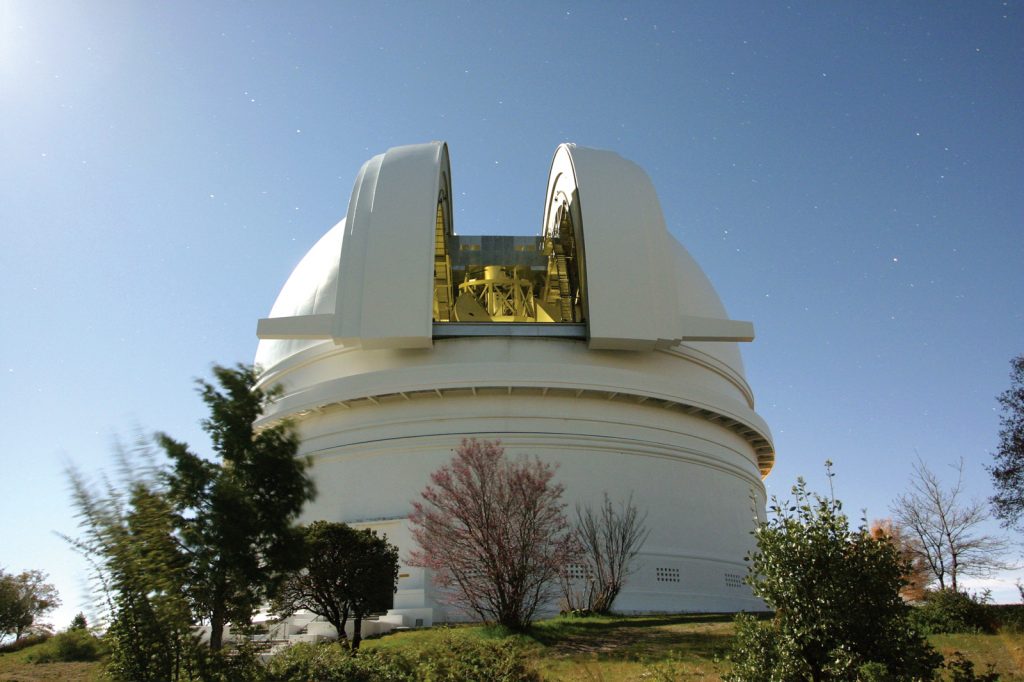
To listen to today’s reflection as a podcast, click here
In 1842, French philosopher Auguste Comte probably thought he was on safe ground when he predicted that humanity would never learn anything of significance about the stars.
Those twinkling lights in the night sky were simply too far away – far beyond our capacity ever to see and appreciate “up close.”
But all that changed during the first half of the twentieth century. Spectacular technological breakthroughs produced what can only be described as the Golden Age of Telescopes. Astronomers competed to build ever larger instruments capable of analyzing astonishingly dim rays of light emitted by stars and galaxies at extraordinary distances.
The engineering challenge has always been the mirrors. More specifically, the glass.
The light from distant objects must be focused and magnified by parabola-shaped pieces of glass – giant slabs that, for want of a better term, must be perfect. There must be no imperfections or bubbles. Enormous reflecting mirrors can only be supported at the edges. And that’s a problem, because huge pieces of glass, like the 200-inch-wide mirror at Mt. Palomar near San Diego, California, have a tendency to sag in the middle because of gravity. Even tiny sags can radically distort astronomical images.
George Ellery Hale, the wizard who crafted the giant telescopes at both Mt. Wilson and Mt. Palomar, learned from trial and error that the parabolic shape of the main mirror must be accurate to within 5% of the wavelength of the light that is being gathered.
What does that mean?
Consider an example. Astronomy professor Emily Levesque points out that blue light coming from distant stars has a wavelength of 400 nanometers, which means the mirror must be ground and polished to within 20 nanometers of perfection. That’s thousands of times smaller than the width of a human hair.
That’s why New York’s Corning Glass Works, in 1934, allowed a full ten months for the giant Pyrex slab that would become the Palomar mirror just to cool, ever so slowly. That was to ensure it didn’t crack. The slab was then transported by rail at a snail’s pace to the West coast. Crowds lined the route. Armed guards provided protection every mile of the way.
The Cal Tech optical shop then took eleven and a half years to grind the glass, ever so slowly, to its ideal shape. In 1948 it was coated with aluminum and painstakingly installed.
Early the next year, Edwin Hubble – America’s foremost skywatcher – took the new telescope on its test drive. Mt. Palomar has been an astronomical superstar ever since, reshaping our understanding of the universe in surprising and spectacular ways.
But that’s nothing.
By the end of this decade, the Giant Magellan telescope – a project funded by scientists from nine countries – is expected to point its eye toward the exceedingly clear skies above the Atacama Desert in Chile. Its mirror is actually a segmented quilt of seven of the largest reflecting surfaces ever made. Digitally operated magnets will coordinate all seven, functionally turning them into a single mirror almost 1000 inches wide.
That will make the Giant Magellan 200 times more powerful than any telescope ever constructed, surpassing even the Hubble and James Webb Space Telescopes currently operating far above Earth’s atmosphere. Incredibly, the new instrument will be able to zoom in on individual stars that are hundreds of millions of light years away.
Take that, Auguste Comte.
If the crafting of mirrors has improved by leaps and bounds within our lifetimes, those who yearned for faithful reflections during Bible times were almost literally in the dark.
Silver-coated mirrors – the familiar “looking glasses” that we moderns could hardly live without – weren’t invented until the Middle Ages. For most ancient people, the best way to catch a glimpse of oneself was to gaze at the surface of a puddle or look down into a bucket of water.
Rich people might own a highly polished piece of metal, such as bronze. But the reflections generated by such “mirrors” were sketchy at best.
That’s the background of Paul’s comment in I Corinthians 13:12: “Now we see in a mirror dimly, but then face-to-face.” Compared to standing in someone’s presence, mirrors were notoriously unreliable windows onto reality.
Here’s how the New Living Translation renders Paul’s message: “Now we see things imperfectly, like puzzling reflections in a mirror, but then we will see everything with perfect clarity. All that I know now is partial and incomplete, but then I will know everything completely, just as God now knows me completely.”
When is “then”? That’s when we will finally see Jesus – personally, face-to-face, real and alive – in the next world.
And in the meantime?
God would surely love for us to be like polished mirrors that accurately reflect who he is. “And we all, who with unveiled faces reflect the Lord’s glory, are being transformed into his image with ever-increasing glory, which comes from the Lord, who is the Spirit” (2 Corinthians 3:18).
Others would look at us – at our character, our attitudes, our actions – and catch a glimpse of Jesus.
Reality, however, is painful. Our hearts are pocked with imperfections. We sag because of the gravity of sin. Others throw a glance in our direction and scoff, “If that’s what happens to someone who follows Jesus, include me out.”
But God doesn’t give up easily.
If our current lives present merely a distorted reflection of his love and grace, it only means he hasn’t finished the grinding process – the reshaping of our lives into the image of his Son.
It’s long. It’s slow. And it rarely feels good.
But when we encounter him face-to-face, and finally see him the way he has always seen us, it will all be worth it.
